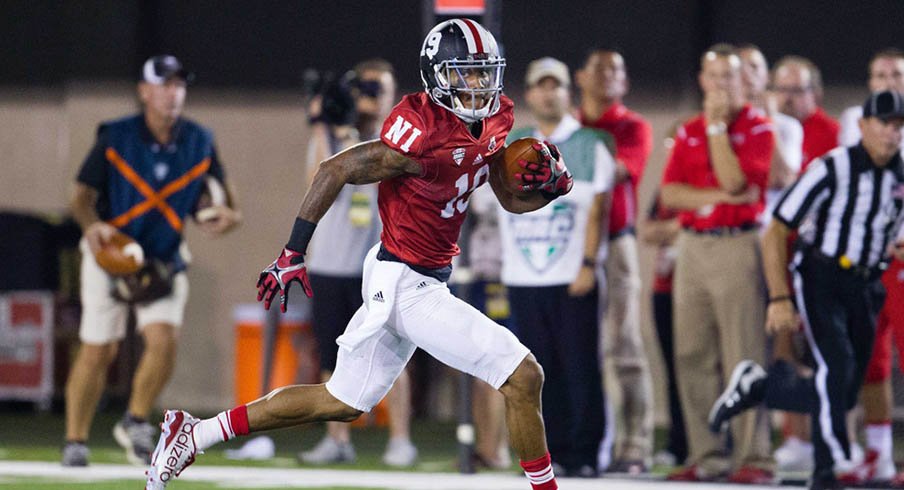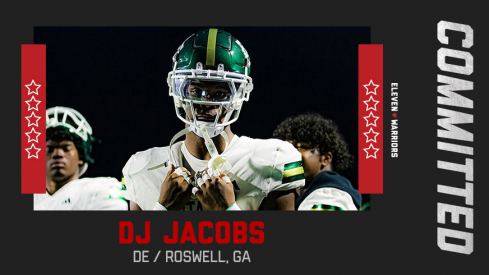You've probably never even heard of him, let alone seen him play.
But Northern Illinois wide receiver Kenny Golladay is not only the breakout star of the Husky offense, but currently sits second nationally with 357 receiving yards. After taking a unique path that took him to the University of North Dakota for two years before transferring up a level to NIU, the redshirt junior has made an immediate impact.
While the level of competition has been less than stellar, Golladay has been the driving force behind an offense averaging 47 points-per-game thus far. Against UNLV in week one, the wideout exploded with 9 catches for 213 yards and followed it up the next week against Murray State with eight catches for 144 yards, including two touchdowns.
The manner in which he's picked up those yards is what stands out on film, as it hasn't been due to coverage breakdowns or from a gimmicky system that naturally has open receivers open downfield. Instead, Golladay has excelled within a scheme built around a power running game.
Though nearly every snap is taken from the Shotgun or Pistol, the Huskies regularly feature a tight end, fullback, or both, in an effort to open up holes inside for running back Joel Bouagnon. With such an emphasis on establishing the run though, chances have appeared for Golladay to get in one-on-one match ups with his defender, and thus far the man wearing #19 seems to be winning them all.
NIU coach Rod Carey and offensive coordinator Bob Cole have successfully implemented run/pass options within their game plans, relying on veteran quarterback Drew Hare to make the correct read. While this might seem like a stretch for a mid-major school, the Huskies have bought in on the concept completely, and with great success.
As the line begins blocking downfield on a simple, 'split zone' run, we can see the left tackle getting upfield to block the middle linebacker, showing a clear intent to block for the running back. However, with the unblocked outside linebacker crashing on the handoff, Hare simply pulls the ball back out and looks up to see an open Golladay running a slant right through the area just vacated by said defender.

While the immediate reaction would simply be to jam Golladay at the line, he's proven to be more than a one-trick pony. Down by 17 to UNLV in week one, the Huskies were forced to look deep in order to get back in the game, and Golladay was able to get off the line and get open before multiple deep balls rained down from Hare.

I know what you're thinking, 'the competition has been nowhere near what Golladay will see from Eli Apple or Gareon Conley on Saturday in Ohio Stadium,' and that's true. However the Huskies find even more creative ways to get him the ball against a 'Quarters' scheme like what the Buckeyes secondary regularly runs.
At it's core, 'Quarters' is a matchup-zone defense, meaning that when a receiver enters your area, you are effectively in man-to-man coverage. For Apple and Conley, that would mean any short routes like the slant, or a deep route down the field that goes vertical after five yards. However, when the receiver breaks on a horizontal route before five yards, the corner hands the receiver off to one of the linebackers, allowing them to pick up the crosser in man coverage.
Given the success of the 'Quarters' scheme on a national level, the Huskies have already shown that they're capable of getting Golladay the ball on these quick crossing routes to take advantage of the mismatch between he and a linebacker.

One such example is the classic 'Hi-Lo' crossing concept that has been a staple of 'west coast' offenses for years, and can be found in virtually every single NFL playbook today, and against 'Quarters' the idea is very straightforward. With the tight end attacking vertically downfield on the right, the cornerback to that side picks him up in coverage, leaving the crossing receiver to one of his teammates inside.
At the same time that receiver comes across the middle of the defense, the slot to the opposite side is running a deeper crossing route, creating a vertical stretch for the middle linebacker, forcing him to choose between who to cover if the entire unit isn't prepared. Against Golladay and NIU, the UNLV defense chose incorrectly, and the former North Dakota punt returner's open-field running ability made them pay.

Now that opponents have been exposed to the well-rounded skills of Golladay, the Huskies are using him as a decoy to open up other areas of the passing game. Murray State allowed the fullback to waltz into the end zone uncovered for the game's first touchdown last week, as the entire defense seemingly focused on the lone receiver on the field near the goal line.

For the Buckeyes to slow down Golladay, they'll have to slow down the rest of the Husky offense first, a feat that should fortunately be much easier to accomplish. After the OSU pass rush teed off on the Hawaii pocket last week, we can expect Joey Bosa and company to be major factors once again in the overall success of the defense. Unlike against the Rainbows though, the Buckeye defensive front will likely have to do so without the added help of the linebackers behind them.
Of Golladay's 17 receptions, only two have come on third downs, the point in which the Buckeyes often transition from their base, 4-3 defense to an aggressive, blitzing 3-3-5 look. Bosa, Adolphus Washington, and the rest of the defensive line must not only get penetration in the running game to set up those long third downs, but they'll also have to get pressure on their own. Hare has already been sacked five times in two games, a total that's not quite Hackenberg-ian, but still lies behind 99 other FBS offensive lines thus far in 2015.
Meanwhile, the Buckeye secondary must play with discipline, not getting frustrated and cheating up against the run. Golladay will get his catches, but is most dangerous after he gets the ball in his hands. The Huskies will undoubtedly try to take advantage of this with a number of quick screens and slants, often away from the strong side of the formation, meaning outside linebacker Darron Lee won't be there to help.
Instead, Apple must keep outside leverage and funnel Golladay inside towards safety Tyvis Powell and linebacker Josh Perry. If the trio is able to bottle up Golladay's big play potential, it will go a long way towards coming up with a big win against an underrated, yet quality opponent.


